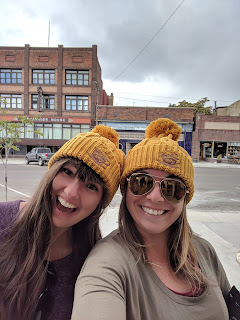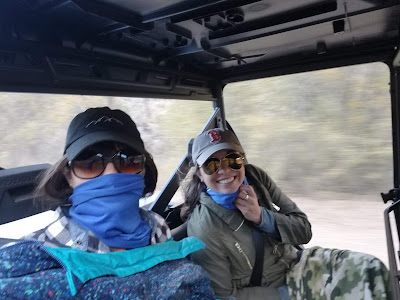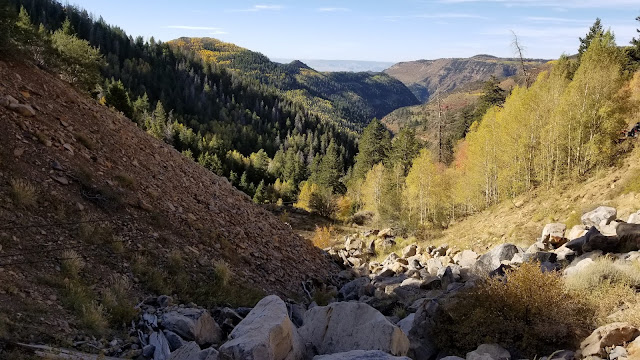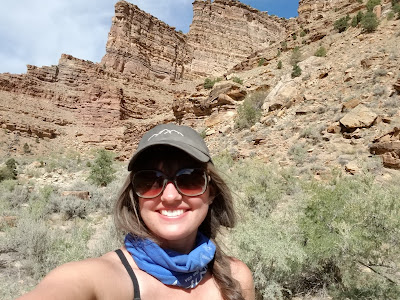Desert Thunder Stock Car Races
Trail Guide- Gordon Greek Waterfall
The ATV road/ trail is just to my right, follow it all the way to the falls!
One short downhill section and you’ll be in my favorite area. Around the bend you’ll cross a small stream and head up a hill.
Not too long after that you’ll be able to see the falls. We first headed to the top of the falls and then came back to that plateau to enjoy the view in front.
Looking out across the top of the waterfall
Trying not to slip
Lots of places to sit, dip your feet if it’s a hot day, and a cool area to explore around the top of the falls… just take care not to slip.
We wandered over to the plateau for a better look at the canyon that Gordon Creek flows through
Not to mention the falls themselves
As there was no one to take our photo… this was the best we could get with a giant pile of rocks and a phone on selfie timer haha
After vising the falls, it’s an easy little drive on the trestle road just past the parking area to see the trestle bridge that crosses over Gordon Creek. (you could see it for a half a minute hiking back from the waterfall from afar)
The Gordon Creek Trestle bridge was built in 1912 and serviced the Mohrland Branch of the Utah line for almost 100 years. It saw it’s last train crossing 6 years ago, and unfortunately, part of the rail deck was burned and damaged so the bridge (in its current state) is not longer safe for use.
Fall Carbon County ATV ride
Map of the route we took.
Half way up the mountain, we stopped to keep the group together, admire a tower up close, and get a little history lesson. The cable line that ran between the towers was constructed in the 1920s and ran 3.5 miles each way, making the line a total of 7 miles altogether. At the time, this was the longest continuous cable in the US.
1. Coal mining in the area got its start in the area in 1883 with the introduction of the Denver and Rio Grande Western Railroad company that needed coal for the trains.
2. Sunnyside started out as Whitmore Coal (in Whitmore canyon) in 1896.
3. The coal mined in the area was of good “coking” quality which means it was excellent for making steel. (by baking the coal in giant ovens, it forced out impurities leaving mostly Carbon behind) Giant coke ovens (650 of them) were created in the area to easily coke the coal before shipping it to areas in the Western US.
4. By 1909, the sunnyside mine was mining 3000 tons of coal/day and by 1914, furnishing nearly 300,000 tons of coke coal per day.
5. Unfortunately the the railroad and copper smelters that were the primary customers of the coke were switching to use of coal directly which made the Sunnyside mine less useful in the 1920s-30s. Luckily though, in 1942, Geneva Steel in Utah valley, and a steel manufacturer in California found plenty of use.
6. With the exception of the war years however, demand for coke was dropping off so the mine struggled. The ovens themselves operated until 1958 when they closed as well.
Pretty fall colors as far as the eye could see
We stopped once more to see the tower where the cable originates before really stopping at the summit, Bruins Point. Here we took a slightly longer break for bathrooms (in the woods, no toilet here) and views of the fall colors surrounding.
TIPS TO HAVE THE BEST ATV ADVENTURE:
1. Wear layers! In the morning shade it was very chilly and at the top of the mountain all day it was windy and cold! Make sure you have a warm jacket/coat, and maybe a blanket to cover your legs!
2. On that same note, bring a good thermos to keep your hot drinks warm in the morning
3. IT WILL BE DUSTY. Don’t wear your Sunday best, make sure to wear sun glasses/ goggles, and have a buff or scarf to cover your nose and mouth when it gets real dusty.
4. Also on that note, bring some nice wet wipes or baby wipes to periodically clean the dust from your face and hands. It makes a huge difference.
5. Bring a map of the area! We were in a tour led group, but there were diverting roads and paths that without a leader or a map could get tricky!
6. MAKE SURE YOU HAVE ENOUGH GAS FOR YOUR JOURNEY
7. Bring a speaker for music, cool drinks for when it gets hots, and have a blast!
Stopping for another short re-group break. Amazing turn out for a first annual event!
Driving through what felt like the Grand Canyon!
Before I knew it, we were admiring our first look at the Indian rock art in the area (which hardly anyone gets to see as we had not yet made it to 9 mile canyon)
See the rock art?
We had our packed lunches (good sandwich, apple, bag of chips, and small dessert) along with our chilled beverages from the cooler, and then went exploring during our 1 hour break. We walked back in along the canyon admiring so many more petroglyphs!
Taking my best guess at what some of the art means!
1. Wondering how 9-mile got it’s name? There’s a few stories out there, but the most likely comes down to when John Wesley Powell (ring a bell?) was exploring the Green River in 1869 ad used a nine mile transect for mapping the canyon.
2. 9-Mile Canyon was inhabited by native peoples for over 8,000 years with the most prolific artists of the area hailing from the Fremont people who lived in the area from 1100-1200 AD.
3. The canyon is often referred to as “The Longest Art Gallery in the World“
as the entire canyon has amazing wall art in abundance.
3. Main points of interest include: An original homestead cabin at the cottonwood Glen Picnic Area, a Granary (ancient building walls) as well as a pit house, and tons of rock art. The most popular sites there are located around Balanced Rock and the Great Hunt Panel.
I’d always heard Utah was home to some wild horses, but had yet to see them with my own eyes. We started off spotting only 2 or 3 here and there before coming across the rest of the herd of around 20 horses, that all started running by.
1. TRAX® PowerSports of Provo: 801-613-8729
- ATV (can fit 2 people) will run you $156-$195 per day depending on length of rental
- Side by side (2 people) is $196-$245 per day
- Side by side (4 people) is $220-$295 per day depending on model and length of rental
- Call for prices
- Call for prices















































































